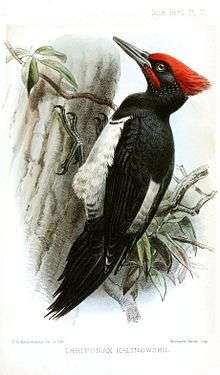Tristram's woodpecker
Tristram's woodpecker (kor.: 크낙새 khunak-sae, jap.: Kitataki) (Dryocopus javensis richardsi) is a Korean subspecies of the white-bellied woodpecker. It was firstly identified and described by English scholar and ornithologist Henry Baker Tristram in 1879.[1]
| Tristram's woodpecker | |
|---|---|
 | |
| Scientific classification | |
| Kingdom: | Animalia |
| Phylum: | Chordata |
| Class: | Aves |
| Order: | Piciformes |
| Family: | Picidae |
| Genus: | Dryocopus |
| Species: | |
| Subspecies: | D. j. richardsi |
| Trinomial name | |
| Dryocopus javensis richardsi (Tristram, 1879) | |
| Synonyms | |
| |
Description
Tristram's woodpecker, with its 46 cm length, is among the largest woodpeckers. Both the tuft and the cheek patches are crimson red; its upper parts are black, which contrast with its white underparts, wing tips and a white rump. It has four toes of which two are directed backwards. Its tail feathers are firm. Its native name was derived from the strange call which sounds like "kullak!"
Habitat and ecology
This woodpecker inhabits dense mountain forests above 1,000 m as well as urban areas. It is commonly found in areas with chestnuts, oaks, poplars, and elms. It prefers dead trees, where it nests in the hollow trunk and searches the bark for insects. The breeding period is from April to May where the female lays three to four eggs. It forages for food before sunrise and it returns its nest at sunset. It can move quickly from tree to tree, and when it perceives danger it jumps into a hollow trunk.
Threats
Historically, Tristram's woodpecker was found on the Japanese island of Tsushima and on the Korean peninsula. Due to intensive hunting and the request for museum specimens in the western world between 1898 and 1902, this subspecies almost completely disappeared from that island. In 1920, Japanese ornithologist Dr. Nagamichi Kuroda found the last specimen on Tsushima. Also, in Korea it became a rare bird due to expansive deforestation. Though it was legally protected since 1952, it had vanished from South Korea by 1989. In 1993, a pair were spotted in the demilitarized zone. Today it only exists in North Korea. Probably fewer than 50 birds exist in the provinces of Kangwŏn-do and North Hwanghae, in particular in the remaining forests of Rinsan, Phyongsan, Jangphung, Pakyon, and Kaesong around the area of Myŏraksan. On May 30, 1968 it was proclaimed as National Monument No. 197 and therefore it enjoyed the special protection of the government. It is listed in Appendix I CITES, but there is no special entry for this subspecies in the IUCN Red List.
In July 2017, South Korean authorities declared the extinction of Tristram's woodpecker in South Korea.[2] Hence, only in the DPRK does Tristram's woodpecker still live.
References
- Beolens, Bo; Watkins, Michael (2003). Whose Bird? Men and Women Commemorated in the Common Names of Birds. London: Christopher Helm. pp. 342–343.
- "사라진 크낙새…물방개도 멸종 위기" KBS뉴스. 2017.07.27
- Greenway, James Cowan (1967): Extinct and Vanishing Birds of the World, Dover Publ., New York
- Austin, Oliver L. and Koruda, Nagahisa (1953): The Birds of Japan In: Bulletin of the Museum of Comparative Zoology at Harvard College. Volume 109. Cambridge, Mass. :The Museum, p. 488-489
External links
- Designated Species of Wildlife (Engl.)
- White-bellied black woodpecker, Korean endemic species (Engl.)